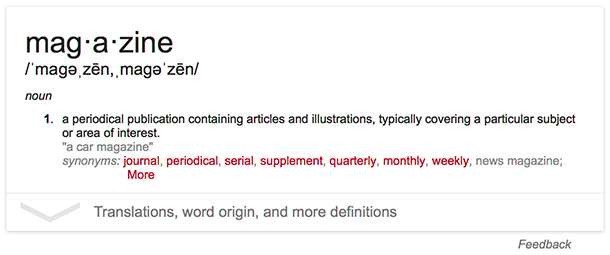 As the magazine media business model continues to evolve, brands push the limits on what they call “magazines.” Where do we draw the line?
As the magazine media business model continues to evolve, brands push the limits on what they call “magazines.” Where do we draw the line?
A magazine by any other name is…still a magazine?
Bo Sacks was asking this question back in 2006, saying: “Just a few short years ago, you could instantly recognize what a magazine was from 20 feet away. It was generally rectangular, constructed with ink, paper, glue or staples. It was portable and required no power source. But what is a magazine today? What will it be as we proceed into the digital age of information distribution?”
For many (myself included), the idea of “magazine” will always include a focus on editorial content curation and presentation in a finite, tangible format, i.e. ink on paper. On the other side of the spectrum, some consider any content at all published by a magazine brand to be part of what they call the magazine, without any kind of border around it.
This summer we see three titles riffing on the traditional idea of the magazine: one’s ad-free, another is content-free, and a third is digitally curated by a company known for its lack of curation and permanence.
“It has been an interesting month for magazines when it comes to formats and business models. First, Rodale announced its 66-year-old Prevention magazine was going ad-free. Secondly, a funny offering from Canada announced it would print a content-free model. Thirdly, Snapchat decided to launch a digital magazine that would live on the web,” writes Jessica Patterson in Fipp.
“Prevention’s July issue was the first to embody a bold vision that carried no advertising pages whatsoever, but delivered pure content,” Patterson explains, as the publisher joins that growing cadre who believe that readers will pay for the content they find valuable.
On the other hand, Toronto-based It Ran takes the exact opposite tack.
“We thought, how funny would that be if we created a magazine called ‘It Ran,’ where people could run any ad they wanted for a fee,” explains publisher Chris Hirsch. “And the fee is their donation to [National Advertising Benevolent Society] this year.”
Finally, we see Snapchat, the model of impermanence, creating the curated content title Real Life that will live in digital space.
“It will be about how we live today and how our lives are mediated by devices…” explains editor-in-chief Nathan Jurgenson.
Clearly, the debate continues on what constitutes a magazine in this digital age. One thing is sure, though…the very idea of a curated compilation of content has lasting value regardless of the changing landscape.
